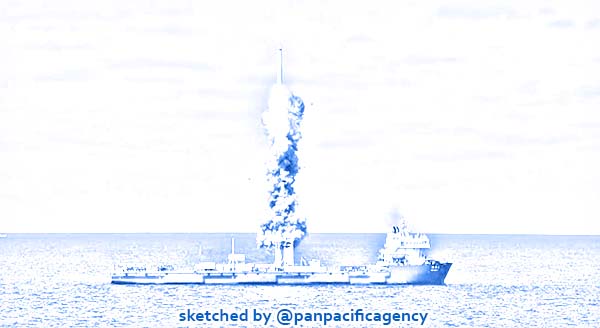[Analytics] US–China rivalry intensifies in the Pacific

China launches a Long March 11 solid-propellant carrier rocket from a ship in the Yellow Sea on Tuesday morning, Sept 15, 2020. [Photo by Wang Weitong/Provided to chinadaily.com.cn]. Sketched by the Pan Pacific Agency.
US–China geostrategic competition is intensifying in the Pacific as both governments commit more resources to battle for influence. Denghua Zhang specially for the East Asia Forum.
The US government released its Indo-Pacific Strategy in February 2022, which fleshes out its policy priorities in the region. This document is based on the ‘Free and Open Indo-Pacific’ concept announced by previous president Donald Trump in 2017. The strategy testifies to US concerns about China, asserting that ‘intensifying American focus is due in part to the fact that the Indo-Pacific faces mounting challenges, particularly from [the People’s Republic of China]’. It lists China, COVID-19 and climate change as core challenges for the United States. Competition with China has received bipartisan support among the US Congress.
The Department of Defense is at the forefront of US engagement with the Pacific. In August 2020 Mark Esper became the first US Secretary of Defense to visit Palau. He and the Palauan president reaffirmed their support of the rules-based international order in a veiled reference to China’s activities in the South China Sea. In May 2021, the Department of Department introduced the Pacific Deterrence Initiative, ‘prioritizing China as the number one pacing challenge’.
Several other sectors will also be involved in US engagement with the Pacific. In a public webinar in December 2021, senior politicians announced that the United States will take a whole-of-government approach to boost long-term engagement with the Pacific in areas such as defence, infrastructure, health, education, climate change, disaster preparedness and maritime security.
In competing with China, the United States will leverage its network of security allies and like-minded partners, which it boasts is its ‘single greatest asymmetric strength’. This will allow the United States to focus on the North Pacific, as the strategy highlights that the United States will prioritise the renewal of the Compact of Free Association with Palau, the Marshall Islands and the Federated States of Micronesia.
Meanwhile, China’s engagement with the Pacific continued to grow in 2021. Chinese President Xi Jinping had telephone conversations with Fijian Prime Minister Frank Bainimarama in June, Tongan King Tupou VI and Solomon Islands Prime Minister Manasseh Sogavare in September and Papua New Guinea Prime Minister James Marape in October, pledging to continue China’s aid.
At the first China-Pacific foreign ministers’ meeting in October, the Chinese government announced the establishment of a China-Pacific Centre on Climate Change Cooperation, a Centre on Poverty Reduction and Development Cooperation and a reserve of emergency supplies. At these meetings, China highlighted Xi’s concept of building a ‘Community of Common Destiny’ and sought support from Pacific island countries on the issues of Taiwan, Hong Kong, Xinjiang and Tibet.
China’s aid to Tonga in the wake of the January 2021 volcanic eruption and tsunami typifies its growing input in the region. China provided five batches of aid to Tonga which included US$44,000 worth in-kind from the Chinese Embassy in Tonga, US$100,000 from the China Red Cross, US$158,000 worth in-kind from the Chinese Embassy in Fiji and US$3.16 million of supplies.
Similarly, China’s engagement with Solomon Islands has increased substantially. Following the riot in November 2021, China dispatched a team of nine police advisors to the Solomon Islands Police. This is the second such dispatchment after China seconded police officers in 2013 and police liaison officers in September 2021 to Fiji. To counter China’s influence, the US government has announced to reopen its embassy in Honiara, which closed in July 1993.
In February 2022, Chinese foreign affairs spokesperson Wang Wenbing criticised the US Indo-Pacific strategy as ‘resurrect[ing] the Cold War mentality and bloc politics’. Chinese scholars’ analyses of the US Indo-Pacific strategy are not yet published, but it is likely that they will focus on the ‘Indo’ part rather than the Pacific. As research in 129 Chinese journal articles on Pacific studies suggests, Chinese scholars tend to approach Pacific affairs from the angle of big power politics.
Infrastructure will be a new area of contest between the two countries. In stark contrast to China, the United States is also expected to support ‘soft areas’ in the region, such as women’s empowerment, anti-corruption, promotion of media freedom, civil society engagement and development. This is evident in US Congressional bills such as the United States Innovation and Competition Act 2021, the Honoring Oceania Act, the Boosting Long-term US Engagement in the Pacific Act and the Strategic Competition Act of 2021. Looking into the future, competition is likely to be a new normal for the United States and China in the Pacific.
Denghua Zhang is a Research Fellow at the Coral Bell School of Asia Pacific Affairs, The Australian National University.